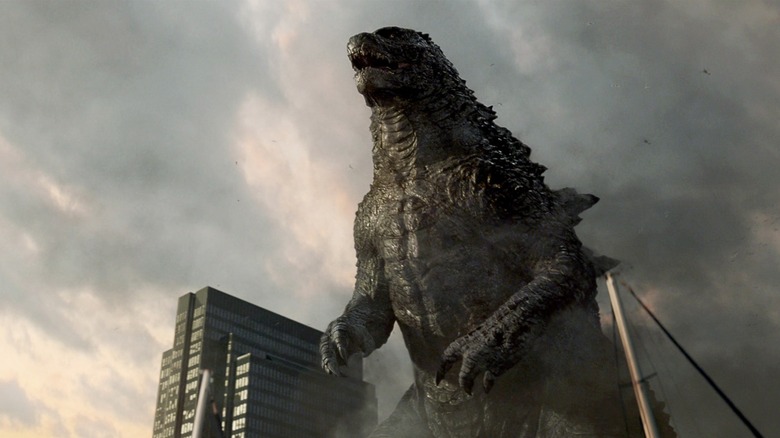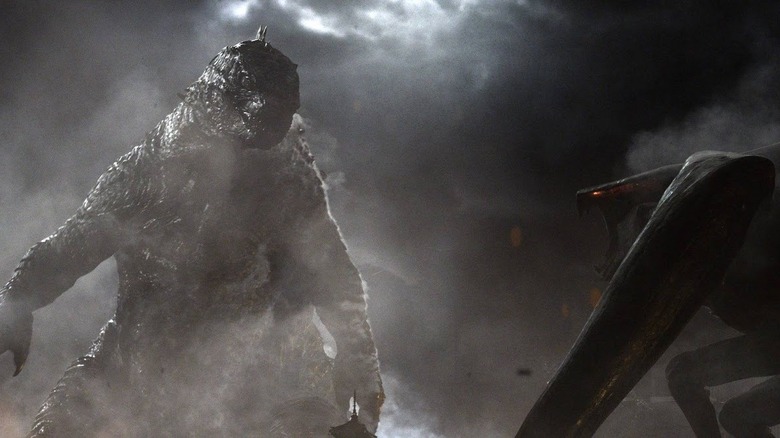The Final Fight In Godzilla (2014) Is The Best Action Scene Ever
(Welcome to Best Action Scene Ever, a column dedicated to breaking down the best, most effective action sequences throughout the genre. In this edition, we ring in the release of Gareth Edwards' "The Creator" by looking back at the director's most underappreciated blockbuster yet and its most enthralling set piece: the climactic city battle in 2014's "Godzilla.")
Sometimes, this column is all about taking a deeper look into all the unquestionable classics of the action genre, breaking down the fundamentals of why they stand the test of time. Other times, it involves shining a light on certain kinds of media that perhaps didn't receive all the credit they were due at the time. And every now and then, this can boil down to taking a stand on some hot takes that might sound hyperbolic (at best) or downright unhinged (at worst). This, my friends, might very well be one of those times.
Many consider Gareth Edwards' "Godzilla" a divisive entry in the kaiju canon for several reasons, though even the biggest 'zilla purists out there can't deny that the 2014 film was an utterly unforgettable experience on the big screen. While the human characters leave plenty to be desired, the filmmaker more than made up for the sin of killing off Bryan Cranston halfway through the movie by taking an impressively measured and restrained approach to making Godzilla scary again. While many chafe at the decision to keep the big guy off-screen for so much of the runtime, borrowing a page out of the "Jaws" and "Jurassic Park" playbook only made the final act of the movie all the more effective than it otherwise would've been.
That's also why the final battle in San Francisco remains a high-water mark in both the franchise and, yes, action sequences overall.
The scene
After the newly-awakened, parasitic MUTOs (Massive Unidentified Terrestrial Organisms) make their way across the globe, the radioactive lure of nuclear warheads finally draws them to the American mainland in San Francisco ... with Godzilla, their ancient and most feared alpha predator, hot on their heels. As the wingless female MUTO uses one of the warheads as the fuel for an entire nest of its spawn, the male stands guard against any potential threats that might appear, whether the puny human military with their firecrackers (although they do make one mean, memorable HALO jump into hell) or, well, something a bit bigger.
Unlike when Godzilla makes landfall in Hawai'i earlier in the story, mostly hidden in mist and constantly cut away from with murky newsreel footage (though don't let that distract you from his masterclass of a reveal in the airport sequence), his grand reappearance in San Francisco finally lives up to the King's title. The buildup to Godzilla's first use of atomic breath is simply a thing of beauty, with the camera and VFX carefully tracking the audience's collective eye from the tip of the big guy's tail all the way to his ugly mug. When he unleashes the first blast on the unsuspecting MUTO, lighting up the night with its fiery blue fury (which, sadly, doesn't translate quite as well from a huge theater screen to, say, your laptop at home), we're watching nothing less than the magic of a VFX expert in the director's chair using every trick in the book to make spectacle as visceral as possible.
Despite the frequent cutaways to Aaron Taylor-Johnson's soldier character and the military's somewhat perfunctory mission with those nuclear weapons, the actual kaiju fight lives up to its billing, leading to Gojira giving the MUTO a fatal case of whiplash.
Why it works
It's all about perspective, baby. Unlike practically any filmmaker currently working today, Gareth Edwards fully understands the importance of conveying size and scale on a blockbuster canvas. His extensive background in VFX work undoubtedly put him in the best position to work with the teams at MPC, Scanline, Wētā FX, and more to craft some of the most convincing and seamless digital effects of any big-budget feature in the last decade. But don't look past all the hard work that must've gone into the staging and pre-vis, figuring out the exact choreography and cheer-worthy moments to truly bring out the best (and worst!) of these gigantic, larger-than-life monsters.
One might think their sheer mass and volume would work against bringing these slow-moving enemies to life, and there are certainly plenty of examples in recent memory (looking at you, "Godzilla vs Kong") where any attempt at conveying weight and scale are sacrificed for flash-in-the-pan thrills that don't stand the test of time. Let's put it this way: something in the human brain all but rebels at the visual of seeing such massive beasts moving faster than they "realistically" could. But to his immense credit, Edwards' work on "Godzilla" never once feels like he viewed this as a constraint — instead, he takes what could've been a limitation and uses it to engineer one show-stopping action beat after another.
The key moment
Was there ever really a doubt? The military's attempts to blow up the MUTO nest, as big a threat as that obviously posed, takes a significant backseat to the brawling kaiju laying waste to the entire city of San Francisco. Still, the continued focus on the human-sized heroes does play an important role in contrasting against the kaiju drama. Like what Guillermo del Toro accomplished a year prior with "Pacific Rim," audiences can only truly feel the gravity and grittiness of the action when filtered through a relatable perspective. That's why so many memorable shots are centered, for example, within cars and buses on the Golden Gate Bridge or from Aaron Taylor-Johnson's point of view looking up at the female MUTO that's only seconds away from devouring him. Put in its proper context, viewers almost have no choice but to feel blown away by the godlike presence of these monsters.
All of that to say that Godzilla prying open the female MUTO's mouth and blasting his atomic breath down its gullet still stands tall as one of the coolest and most thrilling blockbuster moments in the last couple of decades. There's absolutely nothing elegant about it, except for the fact that Edwards, his editor Bob Ducsay, and his cinematographer Seamus McGarvey all team up to make every cut, every framing, and every instance of blocking as effective as they can be. Knowing the precise moment when to cut away from a human perspective and use a wide shot, for instance, goes a long way towards capturing the biggest, most breathtaking moments and translating it in a way that makes our lizard brains want to stand up and cheer. There's all sorts of technical mastery on display, but "Godzilla" cuts right through the noise to hit us on our basest, most instinctual level. Nothing could be more fitting for the King of the Monsters himself.


